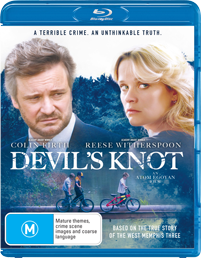The horrific murder of three young boys in West Memphis in 1992 is one of the most unusual and debated cases of the last 30 years. Three young men, Damien Echols, Jason Baldwin and Jesse Misskelly were all found guilty and linked to satanic and occult rituals, but maintained their innocence to a fault. As time went on and more people started to believe them, further investigation revealed a case of shocking inconsistencies and misconduct, shrouding the murders in a cloud of mystery. The case has already been covered in documentary form, in the 'Paradise Lost' trilogy and in the recent ‘West of Memphis’, but was finally adapted into a narrative film with acclaimed director Atom Egoyan at the helm. Can ‘Devil’s Knot’ offer anything new to say that hasn’t already?
The two central figures at the heart of ‘Devil’s Knot’ are Pam Hobbs (Reese Witherspoon), the mother of one of the victims, and Ron Lax (Colin Firth), an investigator working with the defence team for the boys. Pam is driven by her overwhelming grief and Ron is driven by a hatred for the death penalty, which surely awaits the boys if they are found guilty. As each independently is drawn deeper into the case, reasonable doubt begins to appear, and both begin to question not only whether the boys have anything to do with the murders at all, but even more importantly, who actually did.

‘Devil’s Knot’ has a number of hurdles to jump, not least of which are the acclaimed documentaries that precede it. The case of the West Memphis Three is well-trod ground, but while the film has little new to offer, it effectively provides a dramatic recreation of events, often with unexpected flair. This is a case of conflicting voices and contradictions, and Egoyan takes full advantage of this. As it progresses, you get the feeling of spinning into some kind of surreal nightmare, where nothing makes complete sense, and much credit for this must go to editor Susan Shipton. It’s a disorienting effect similar to that done in ‘Prisoners’ (2013), and lifts the film from simply being a police procedural. The other hurdle, however, is more significant, and one the film never quite solves; the sheer scale of the case itself. ‘West of Memphis’ is three hours long, and ‘Paradise Lost’ takes three films to cover everything. At just under two hours, there simply isn’t enough time to get to the meat of the case, even if it remains essentially unsolved. It simply covers the court case against the boys, and while there are copious end titles to fill us in, there’s no sense of satisfaction at the end. It’s certainly a film that pulls you in, but unlike a film like ‘Zodiac’ which leaves unanswered questions but a tremendous sense of completion, ‘Devil’s Knot’ never quite gets there.
The film effectively provides a dramatic recreation of events, often with unexpected flair.
Performances across the board are excellent if not quite memorable. Colin Firth suffers most from the often obvious screenplay, and Reese Witherspoon often threatens to be caught playing emotion too much (something akin to Sean Penn’s atrocious work in ‘Mystic River’), but by the same token pulls out some unusual and chillingly incongruent moments that save it from being too much. Everyone involved in the cast seems to be very much in sync with the unusual tone Egoyan is going for, and this is very much for the better.
What you’re left with at the end of ‘Devil’s Knot’ is a strong sense of being haunted. Nothing seems entirely clear about the story you’ve just witnessed, and as it should be. It isn’t quite as rousing as it seems to think it is, but it certainly isn’t without trying. As an introduction to the case of the West Memphis Three, it certainly does an excellent job, and all the better that there are the excellent documentaries to follow it up with. For those that know the case though, it’s nothing more than a curious meditation on a story we already know.
PICTURE & SOUND
Paul Sarossy’s sombre cinematography has been well-preserved with Icon’s 1080p 2.35:1 transfer. It isn’t remarkable, but detail is clear, and the deep greys and blues look gorgeous in high definition. The sound, however, is problematic. Oftentimes with this DTS-HD MA 5.1 track, I found myself struggling to understand the dialogue and had to resort to the subtitles. It may have been a fault with my system, but the balance of dialogue and sound seems a tad off.
SPECIAL FEATURES
Unfortunately there are no special features on this disc. That’s a pity, as I suspect there might be a lot of material still sitting on the cutting room floor.
To win one of three Blu-rays thanks to Icon, just make sure you follow both steps:
| 2 |

/toppic/devilsknot3.jpg)
/filters:quality(75)/rating/M.png)
/filters:quality(75)/toppic/final-destination-bloodlines.jpg)
/filters:quality(75)/toppic/the-wedding-banquet.jpg)
/filters:quality(75)/toppic/kingdom-of-heaven.jpg)
/filters:quality(75)/toppic/the-accountant-2.jpg)
/filters:quality(75)/toppic/nt-live-dr-strangelove.jpg)
/filters:quality(75)/toppic/sinners.jpg)
/filters:quality(75)/toppic/drop.jpg)
/filters:quality(75)/toppic/warfare.jpg)
/filters:quality(75)/toppic/death-of-a-unicorn-2.jpg)
/filters:quality(75)/toppic/a-goofy-movie.jpg)

/filters:quality(75)/toppic/thelionking.jpg)
/filters:quality(75)/toppic/thelandbeforetime2.jpg)
/filters:quality(75)/toppic/thetreasureofthesierramadrid.jpg)
/filters:quality(75)/toppic/buffy.jpg)